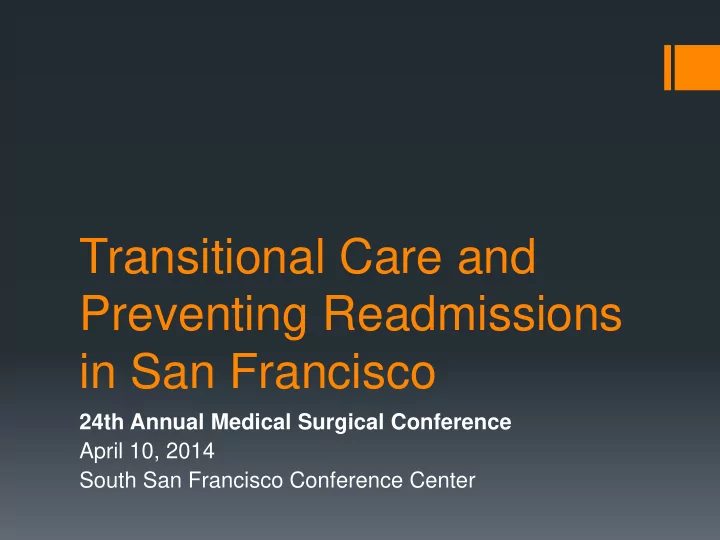

Transitional Care and Preventing Readmissions in San Francisco 24th Annual Medical Surgical Conference April 10, 2014 South San Francisco Conference Center
San Francisco Transitional Care Program Carrie Wong, MSW, MPH, LCSW Director of Long Term Care Operations San Francisco Department of Aging and Adult Services Carrie.Wong@sfgov.org
Abstract Community-based Care Transition Programs have been used to reduce costs by preventing unnecessary hospital readmissions, and improving the quality of care and the overall patient experience. The San Francisco Transitional Care Program is a unique partnership of government, hospitals, and community-based organizations with innovative approach to a seamless delivery of services from within hospital walls to the community, to secure better health outcomes, and to reduce healthcare costs without adverse human costs.
Learning Objectives To understand the context for Medicare Innovations, transitional care, and health care delivery To understand how the complexity of socioeconomic factors, health literacy, and support systems affect health outcomes
Agenda Why is transitional care important? Background Program Description Challenges Readmission Outcomes Questions?
Why is Transitional Care important? Making it personal…
Background Almost one out of every five Medicare patients (approximately 2.6 million seniors) discharged from a hospital is readmitted within 30 days Total cost is over $26 billion every year Multiple factors along the care continuum that impact readmissions. Centers for Medicare and Medicaid Services created Community-based Care Transitions Program to encourage communities to work together to improve quality, reduce cost, and improve patient experience.
The Community-based Care Transitions Program (CCTP) Created by Section 3026 of the Affordable Care Act Launched in 2011 Test models for improving care transitions from the hospital to other settings and reducing readmissions for high-risk Medicare beneficiaries. Also a part of the Partnership for Patients which is a nationwide public-private partnership that aims to reduce preventative errors in hospitals by 40% and reduce hospital readmissions by 20%
Goals of the CCTP To improve transitions of beneficiaries from the inpatient hospital setting to other care settings To improve quality of care, to reduce readmissions for high risk beneficiaries To document measurable savings to the Medicare program
CCTP Participants 102 participants nationwide California has 11 CCTP Teams Northern California San Francisco Sonoma Marin Southern California Anaheim Glendale Los Angeles Reseda San Diego San Fernando Ventura
San Francisco Transitional Care Program A formal partnership that includes the Department of Aging & Adult Services, NCPHS/SF Senior Center and multiple community-based organizations and hospitals to: Help eligible older adults and adults with disabilities to transition safely from hospital to home Reduce unnecessary acute hospital readmissions
Target Population Older adults (age 60 or older) Adults with disabilities (age 18 to 59) Cognitive impairment Little or no formal or informal supports and/or lives alone Chronic illness and/or more than three medical co-morbidities Two or more readmissions within the last 6 months Difficulty managing medications and/or taking 8 or more routine medications Needs assistance with 2 or more activities of daily living Demonstrated need for service/resource to avoid readmissions
Eligibility Criteria Payor source: MediCare fee-for-service and MediCare/MediCal (eventual expansion to uninsured and MediCal only) Seniors age 60 & older or adults with disabilities age 18-59 A resident of San Francisco In stable housing Referred by hospital during acute medical hospitalization Client, family or friends are able to benefit from coaching or care coordination services Willing to accept services
Infrastructure • Collaboration of county, 8 hospitals, and 8 community-based organizations to address a citywide issue • Specialized committees to guide program aspects -- Governance, Steering, Finance • Centralized Intake System at Dept of Aging and Adult Services for information and referrals for SFTCP and other county services such as IHSS, APS, HDM, CLF, and I&R • Web-based electronic client database for data management and reporting
Main Roles Hospital Liaison with DAAS Intake Assist hospital staff/units with program information and referrals Initiate patient intervention during initial hospital visit Collectively cover all 7 hospital campuses every weekday Transitional Care Specialist Provide transitional care services in the 5 focus areas Complete home visits and appropriate follow up Arrange for service packages (transportation, meals, or homecare) Stabilize and refer to long term resources Complete Patient Activation Survey
Program Staff Language Capacity Program Manager Cantonese Intake Coordinator Mandarin Clinical Supervisor Toisanese 11 Transitional Specialists Japanese Russian Spanish Tagalog Vietnamese
The Intervention Coaching and care coordination model Transitional care services provided between 4-6 weeks after an acute hospitalization Hospital visit 24 hours prior to discharge Home visit within 3 days after discharge Additional home visits if needed Phone calls Service packages of meals, home care, and transportation Referrals to case management and other services as needed after transitional care services are completed
Client Areas of Focus Set a recovery goal Understand one's health issues and role of medications Recognize symptoms and have a plan of action if they occur Develop “My Wellness Plan” – a tool to organize health information Secure/prepare for the first PCP appointment including questions and concerns Establish services/resources with emphasis on nutrition, transportation, care at home
Program-to-Date Outcomes 1346 clients referred 1317 clients enrolled initially 1192 clients completed the intervention 89.5% or 1079 clients successfully transitioned home 10.5% or 113 clients were rehospitalized * Preliminary data between December 2012 – November 2013
Types of Services Provided – 38% Coaching only 13% Care coordination only 48% Both coaching and care coordination * Preliminary data from April 2013 to November 2013
5 Focus Areas at Case Completion 100% of clients used My Wellness Plan 87% of clients were able to manage medication 90% of clients went to their first doctor appointment 76% of clients knew their own health “red flags” 54% of clients needed and accessed additional community based services * Preliminary data from April 2013 to August 2013
Readmissions for SFTCP Clients
Readmissions
Referrals vs Enrollments
Ongoing Challenges
Contact Carrie Wong, MSW, MPH, LCSW Director of Long Term Care Operations San Francisco Department of Aging and Adult Services Carrie.Wong@sfgov.org
Recommend
More recommend